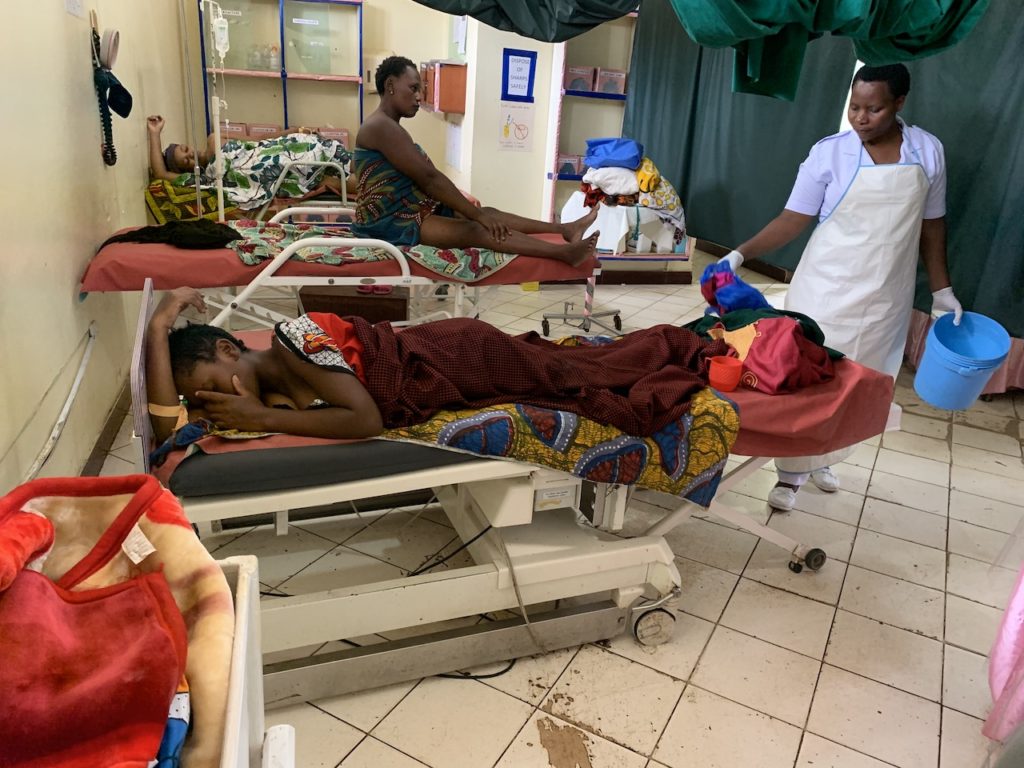Case #s 3-5: A Rough Day in Maternity

The woman in the foreground with her hand over her face is a 22-year-old who had arrived to the hospital by motorcycle just a bit before this picture was taken. You can see her baby wrapped in a red fuzzy blanket in the left lower corner of the photo. She had delivered an approximately 20-week fetus at home and brought it with her, wrapped as shown, on the motorcycle. Her husband was driving the motorcycle while she and another male relative, holding the baby, were riding on the back. She hadn’t yet delivered the placenta, so that was done in the hospital. Needless to say, her baby was too young to survive. After about 30 minutes or so, she was asked to get up off the gurney and walk herself to her inpatient bed. Ordinarily she would have been placed in the postpartum ward, full of moms with new babies, but some of the other volunteers and I advocated for her to be put in the antepartum ward (women waiting to have babies) and this was accepted. Not sure whether we were fixing a problem or just creating another cultural faux pas. In either ward she would be sharing a bed with another mama.
The lady in the middle is a nice healthy 25-year old about to deliver her second child. The delivery was smooth and uneventful, and she promptly hopped up off the bed and walked herself to her bed in the postpartum ward next door. All expectant moms are asked to bring with them linens for wrapping the baby and dressing their hospital beds as well as all of the gauze and disposable absorbent material needed for the delivery, suture and needle for repair of the inevitable tear or episiotomy, and rubber bulb suction and plastic umbilical cord clamp for the baby. This collection of necessaries come in a pack that can be purchased at the hospital pharmacy upon arrival.
The young lady at the back is another 22-year-old here to deliver her second child. The baby was estimated to be more or less at term, but mom has insulin-dependent diabetes which had been poorly controlled during the pregnancy; her prenatal records showed blood sugars solidly in the 300s (normal 60-120) at her clinic visits. We couldn’t figure out whether her diabetes predated the pregnancy or was just gestational. In either case, her previous pregnancy had resulted in a stillbirth. On arrival the day before she had an ultrasound which again showed tragedy: no fetal movement or cardiac activity. Although I’m guessing that the patient already suspected this before arriving at the hospital, it’s not clear that she had actually been told of the ultrasound result, as it came during the evening when there were no regular doctors’ rounds being done. Nonetheless, that night she was given misoprostol, a medication meant to induce labor and start the painful process of delivering the dead baby.
By morning, she was not experiencing any signs or symptoms of labor, so a prolonged discussion was going on amongst the doctors as to whether she should have a Cesarean section. She had not previously had surgery and her risk would be higher because of the diabetes. During this decision-making process, she went into labor. Atypical for her culture, her emotional response to the pain was so dramatic that at one point we thought she was having a seizure and contemplated the additional complication of eclampsia. This resolved, but at that point C-section became a more appealing option as labor did not seem to be progressing very effectively. We attempted to estimate the fetal weight by ultrasound, but the baby had so much edema, that the measurement was certainly inaccurate.
Finally, the decision was made to proceed with C-section. The patient was informed and her distress increased. The nursing staff began making the usual preparations. There was no glucometer available to immediately measure her current blood sugar, but the lab ran a quick blood sugar measurement and it was in the 300s. Insulin was ordered. The patient’s blood was typed in the blood bank and came back as AB negative, a very rare blood type that Tengeru’s blood bank did not have in stock. To make matters worse, the electricity had gone out to the Major Theatre (OR building). The surgeon quite reasonably did not feel comfortable performing a potentially bloody surgery on an out-of-control diabetic without electrocautery, proper lighting, or the possibility of a blood transfusion, so they ended up transferring this patient to Mt. Meru Hospital, the larger and better-equipped local hospital in town, but I worried that it was taking so long to get this patient delivered.
Keep in mind that throughout all of this, the middle lady with the healthy pregnancy and baby was laboring away and delivering a nice fat baby who screamed and cried and was congratulated and wrapped in a brightly-colored new khanga (brightly colored print cloth) and fussed over. I really can’t imagine the kind of pain that the other two were experiencing. Maternity wasn’t like this every day, but I don’t think it was entirely atypical, either. Yet another reminder that when I went home after delivering big old Nelson via C-section, not according to my “birth plan”, I was nonetheless extraordinarily blessed.
If you, too, are feeling blessed, consider donating to Tengeru via my GoFundMe:
